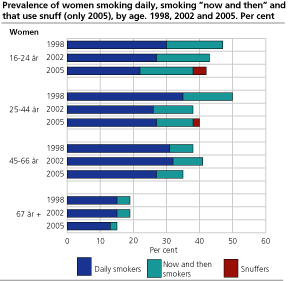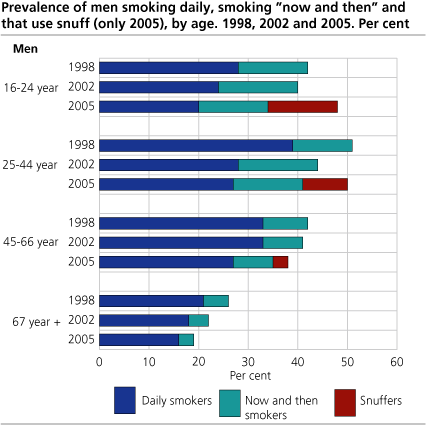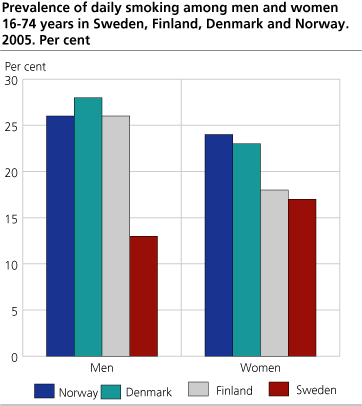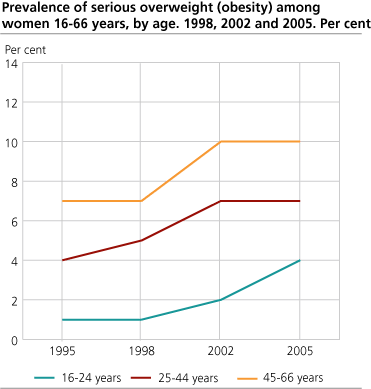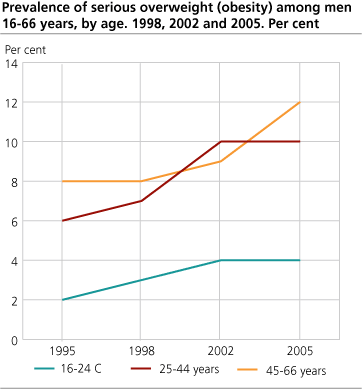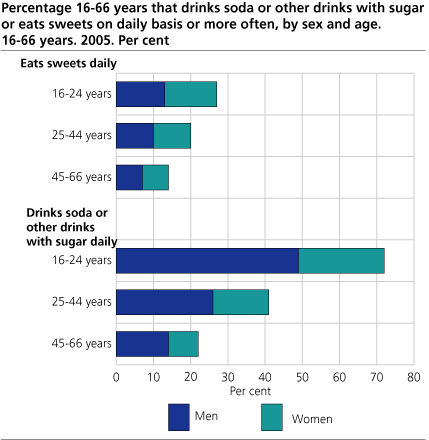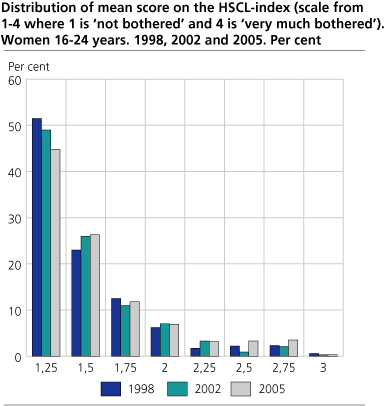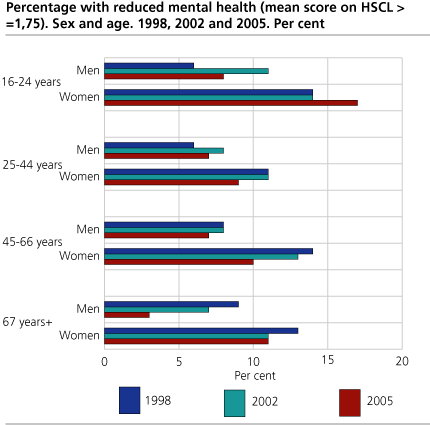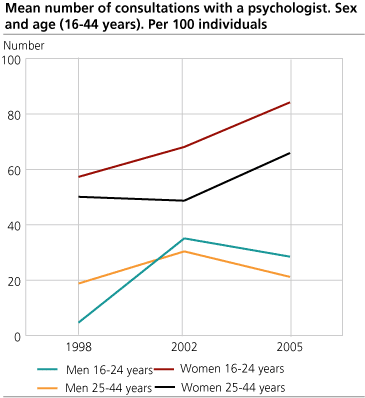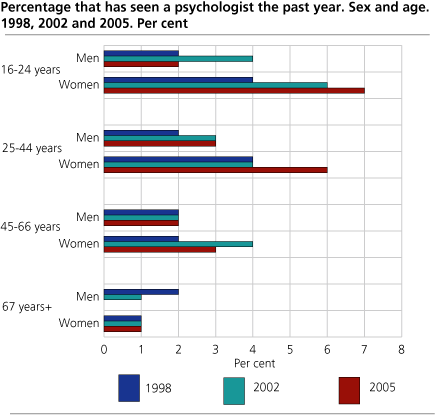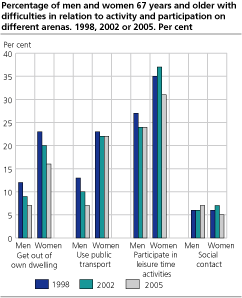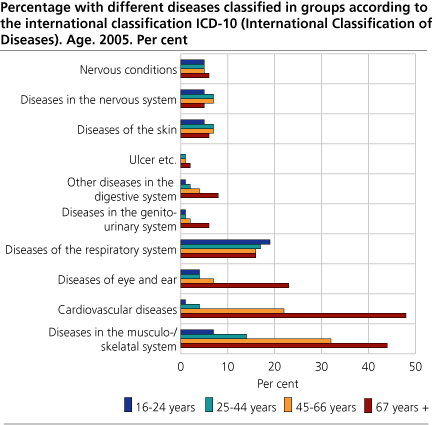Content
Published:
This is an archived release.
Little change in total tobacco use
The level of daily smoking is reduced, while the level of ”now and then” smoking remains the same. More people are involved in physical activity, and fewer are passive, but the population of obese is growing.
The survey of level of living concerning health, care and social contact 2005 shows that the prevalence of tobacco use in the population remains more or less unchanged from 1998 to 2005. The level of daily smoking is reduced, but the number of “now and then” smokers remains unchanged. The percentage of snuffers is relatively high for young people.
Figures for 2005 shows that 24 per cent of the population smokes on a daily basis, 10 per cent smokes ”now and then”, and 4 per cent uses snuff. There has been a reduction in daily smoking in all age groups. Also among 45-66 year olds, where the reduction has been lowest up till now, there has been some movement. In this group there has been a reduction from 32 and 33 per cent in 1998 and 2002, to 27 per cent in 2005. The percentage that smokes “now and then” is unchanged from 1998 to 2005 for all age groups. Young people have the highest percentage of “now and then” smokers (15 per cent). The restrictions on smoking in public establishments have not influenced the level of “now and then” smoking. However, there might be changes behind the figures. It is probable that some daily smokers have reduced the level of smoking and that some “now and then” smokers have stopped smoking all together. |
The survey of level of living concerning health, care and social relations (Health Interview Survey) is a stable and regular source for data about different aspects of the population’s health. The survey runs every three years. The data is representative for the population living i private homes. Every survey gives a picture of the population’s health on a given point in time. The regularity of the survey supplies data so that we can follow changes over time. The survey covers data on self-rated health, about illness, disability, living habits and utility of health services. The information being gathered is based on personal interviews with approximately 7 000 individuals.
The Sweds in front
There has been a dramatic reduction in the percentage of daily smokers in Sweden in the past ten years (NOMESCO). In 2005 17 per cent of Swedish women and 13 per cent of Swedish men smoked daily. The reduction has not been as fast in Norway. Norwegian women are on top of the statistics for daily smoking in the Nordic countries. The percentage of Norwegian men smoking daily is on the same level as in Finland, and a little behind Denmark.
Snuff - more common among boys
The survey of level of living concerning health shows that 14 per cent of boys between 16 and 24 years of age and 10 per cent of men (25-44 years) uses snuff on a regular basis. 4 per cent of young women and 2 per cent of women 25 and 44 years old use snuff. In Sweden, often called the homeland of snuff, 26 per cent of boys 16-24 year old and more than 30 per cent of men 25-44 year old use snuff regularly. For women 16-24 years and women 25-44 years in Sweden, the percentages are 5 and 4 per cent, respectively.
A more active population, but ...
The figures for 2005 indicate that the level of physical activity in the population is rising. The percentage of people exercising regularly is increasing among middle aged and older people. The percentage of people that never exercise is also substantially reduced in all age groups. It is a tendency towards an artificially high increase from 2002 until today. The reporting can to some degree be an effect of increasing focus in the media on inactivity. Generally, it is becoming more and more difficult to give information on living habits that is not seen as socially acceptable. This is also relevant for other questions on living habits (ex. smoking) that is posed in an interview setting
Body Mass Index (BMI)BMI is computed as the relation between bodyweight (in kilo) and squared body height (in metres). Weight/height*height |
...still a heavier population
The percentage with serious overweight and obesity has risen in most western countries. This tendency is also valid for Norway, however not as dramatic. In the US one third of the population (20-74 years) is obese. In Norway there has been an increase in the percentage with obesity the past 10 years. Among men between 45 and 66 years of age and among young women (16-24 years) there has been an increase from 2002 to 2005. Also in Sweden there has been an increase in serious overweight among young girls. For other age groups the trend has stabilized on a 2002 level.
One in two boys drinks soda every day
The percentage of people drinking soft drinks with sugar every day or several times a day is fairly high. One in two young boys (16-24 years), and one in four men 25-44 years drinks soda or lemonade daily or more often. There is less soda drinking among young females, compared to young males.
Increase in young women seeing a psychologist Open and readClose
The elderly of today are more fit than ever. It has, however, been an increase in mental health problems among young women. They are also seeking professional help for their problems.
Psychiatric ward has been a health political focal point for some time. The survey of level of living 2005 shows that one in ten have mental difficulties. This percentage has been stable since the survey in 2002 and 1998. Figures for age and sex show that there has been a reduction in mental health problems for both women and men in most age groups. There has, however, been an increase in young women with problems. Figure 2 shows the distribution of mean score on an index for psychiatric difficulties (see box about HSCL) for women between 16 and 24 years of age. The distribution shows that more young women have higher mean scores on the index in 2005 than 2002. Higher scores indicate more serious difficulties.
Statistics Norway’s survey of level of living concerning health, care and social relations (Health Interview Survey) is a stable and regular source to data about different aspects of the population’s health. It runs every three years. The data is representative for the population living in private homes. Every survey gives a picture of the population’s health on a given point in time. The regularity of the survey supplies data so that we are able to follow changes over time. The survey covers data on self-rated health, illness, disability, living habits and utility of health services. The information that is gathered is based on personal interviews with approximately 7 000 individuals. |
More women under 45 years of age have consulted a psychologist the past year in 2005 compared to 1998. In 1998 4 per cent of young women had consulted a psychologist. The percentage has increased to 7 per cent in 2005. The percentage for young men at the same age was 2 per cent. This percentage is unchanged since 1998. The number of consultations with a psychologist has also increased in the same period. Mean figures show an increase from 53 to 84 consultations per 100 women (16-24 years) from 1998 to 2005. For young men there has been an increase in consultations from 1998 to 2002. In 2005 the number has gone down again. In 2005 there were 29 consultations per 100 men (16-24 years). A rise in consultations can, however, be an effect of more available services and increased resources in the sector in the same period.
The level of living survey shows that four in five evaluates own health as good. Health, as it is captured in population surveys, changes slowly. The distribution of answers to the question “How is your health in general. Would you say it is very good, good, neither good nor poor, poor, very poor” has remained stable since the mid nineties. About 6 per cent says that their health is poor or very poor -.12 per cent of elderly and 1 per cent of youngsters. There is, however, a large proportion that has a long term disease, injury or disability. 58 per cent of the grown up population living in private homes have a long term health problem. A high percentage shows probably that having a chronic health problem of some kind is more common that having none.
... but one in ten has considerable health problems
Disease, injury and disability that are registered in the survey are evaluated in relation to how the interview persons experience the health problem and whether they have consequences in every day life, or set restrictions on what they are able to do. One third of the population has health problems that influence on their daily activities. 11 per cent has health problems that set high restrictions on what they can do. The percentage has been stable from 1998 to 2005. The percentage is highest in the oldest age group (28 per cent) and lowest in the youngest age group (5 per cent).
A more equal age profile for some diseases
The prevalence of most long term diseases increase with age. This involves cardiovascular diseases, diseases in the musculo/skeletal system and digestive and eye/ear diseases. However, it seems that some diseases over time have become as common among young people as elderly people. This concerns primarily diseases in the respiratory system, nervous system and skin diseases. Nervous diseases like anxiety, depression or nervousness are reported just as often by young as by elderly people in 2005.
Hopkins Symptom Check List (HSCL): Mental difficulties are extracted from a sequence of 25 questions on symptoms of mental health problems the interview persons have had 14 days before the interview. The answers to the questions are summed into an index and a mean score is computed. A score equal to 1,75 or higher on a scale from no bothers (1) to very much bothers (4) gives an indication of mental problems. |
The trend is continuing – elderly is getting more fit
Elderly people seem to get fitter despite illness and health problems. This is a good signal considered the announced wave of elderly and future need for care. The survey shows that relatively fewer have difficulties with activity and participation today compared to reported difficulties in earlier surveys. The reduction is greatest for older men above 66 years of age. Fewer people have problems with getting out of own dwelling. A reduction from 19 per cent in 1998 to 12 per cent in 2005. A lower percentage has problems using public transport. While the percentage having problems was 19 per cent in 1998 it is reduced to 14 per cent in 2005. This must be seen in relation with better living conditions when the elderly of today grew up compared to older generations. Increased availability in society that has also improved the situation for elderly and disabled people.
Statistics Norway’s survey of level of living concerning health, care and social relations (Health Interview Survey) is a stable and regular source to data about different aspects of the population’s health. It runs every three years. The data is representative for the population living in private homes. Every survey gives a picture of the population’s health on a given point in time. The regularity of the survey supplies data so that we are able to follow changes over time. The survey covers data on self-rated health, illness, disability, living habits and utility of health services. The information that is gathered is based on personal interviews with approximately 7 000 individuals.
Find more figures
Find detailed figures for Health, care and social relations, survey on living conditions
Contact
-
Elin Skretting Lunde
E-mail: elin.skretting.lunde@ssb.no
tel.: (+47) 92 42 70 07
-
Jorun Ramm
E-mail: jorun.ramm@ssb.no
tel.: (+47) 92 08 23 99
-
Berit Otnes
E-mail: berit.otnes@ssb.no
tel.: (+47) 45 00 49 34

